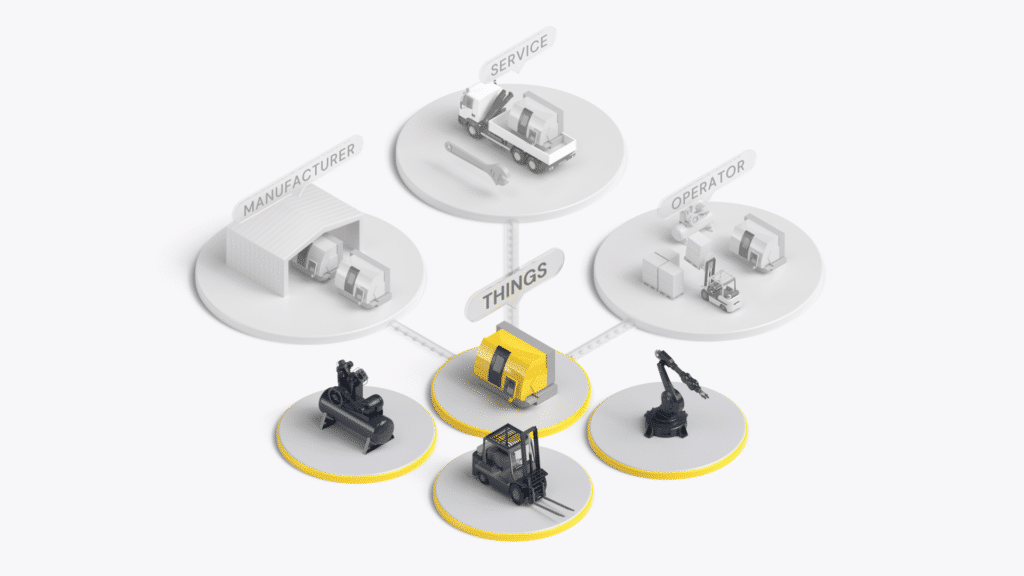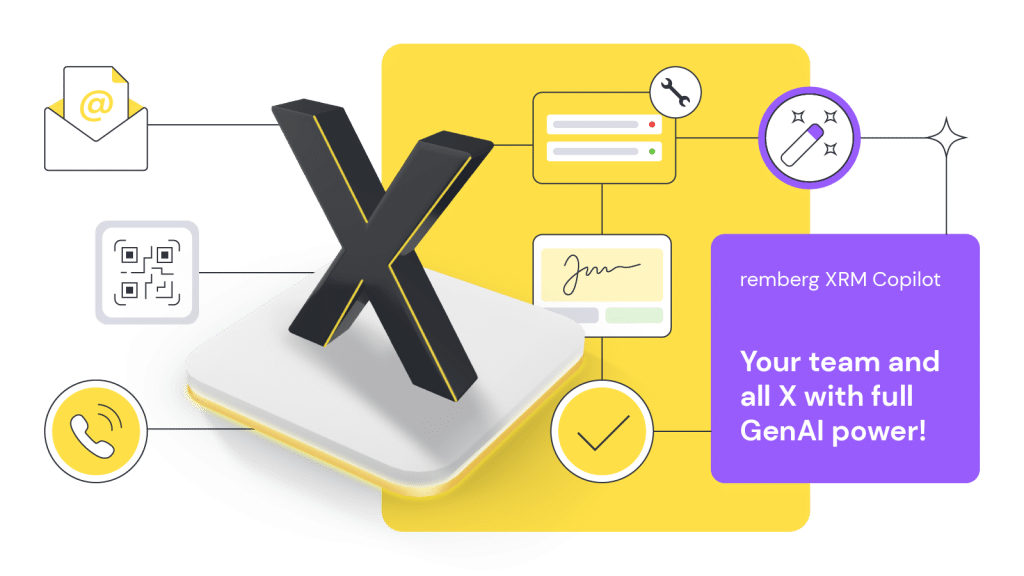Most people in the business world are familiar with CRM (Customer Relationship Management). As the term suggests, customer relationships are usually managed in a CRM. In an XRM (Extended or Anything Relationship Management), on the other hand, the focus is on relationships with X = plants, equipment, buildings, vehicles and other objects or assets.
In CRM, the focus is on customer relationships.
In XRM, the focus is on relationships with X = facilities, equipment or assets.
More precisely defined, XRM refers to the systematic design of an organization’s interactions and relationships with existing, purchased, operated or already sold assets. The aim of XRM is to simplify relationships with systems or equipment and to digitalize the associated processes, e.g. in installation, service, maintenance, repair and servicing, ideally even across company boundaries.
The world is becoming increasingly connected: “Anything that can be connected will be connected”.
This also means that the relationships and interactions in a networked world are becoming increasingly complex, meaning that traditional concepts and logics are no longer sufficient to deal with this complexity in a meaningful way.

What is a XRM Software?
XRM solutions are used in different application areas and are therefore usually modular in structure. Companies can individually select which functions they really need to manage their objects. When managing objects over their entire life cycle, two events are of particular importance:
- Planned events (e.g. installation, commissioning, maintenance, etc.)
- Unplanned events (z.B. faults, damage etc.)
XRM systems therefore offer appropriate functions for these two processes in particular.
In the case of planned events, such as installation, commissioning and maintenance, these are, for example:
- Creation of maintenance plans, based on defined maitnenance or inspection intervals
- digitale work orders and instructions, that can also be accessed via mobile phone
- a digital planning board, that enables clear scheduling of all employees
In the event of unplanned incidents such as faults or damage, for example:
- a ticketing system, that centralizes all internal and external inquiries
- the digital planning board, which allows capacities to be scheduled with a single click
- digital work orders, that describe the incident in detail
Companies select their XRM software modules depending on the use case. In a field service use case of “X=charging stations”, everything from ticketing and the planning board to reporting is required. In the case of “X=special vehicles”, maintenance and repairs may be carried out by external companies in repair workshops – in this case, the company only needs the other modules.
How does XRM software work?
In addition to the basic master data, all interactions with employees, external partners or customers, e.g. via email, telephone or other channels, are also mapped in the XRM in relation to the respective X. In addition, the XRM software can automatically integrate further information on activities and store details such as special features of machines in relation to service, maintenance and repair. The XRM software also supports the management of tickets or requests, their documentation and the creation of maintenance plans.
The XRM system structures all this information clearly so that users get a comprehensive overview of assets, contacts and organizations and understand the managed objects better and better over time. In summary, XRM software helps to keep all X under complete control with a 360-degree view and to digitize the associated processes in a timely manner.
AI superpowers for your service & maintenance teams

In future, the full power of AI will be available to you at the touch of a button within important functions of your remberg XRM.
The importance of XRM
There are three major trends in the industry in which XRM software plays an important role:
Counteracting the shortage of skilled workers
Assets and equipment are of crucial importance in almost all industries. Their installation, maintenance and repair require qualified technical personnel, such as service technicians and maintenance teams. However, we are faced with the problem of a pronounced shortage of skilled workers in these areas. By implementing XRM systems and increasing the productivity of these professionals by over 30%, we can accelerate significant projects such as the energy transition. More efficient installation and maintenance of renewable energy systems brings such ambitious goals within reach.
Better collaboration with partners
The use of an XRM significantly improves collaboration between partners. Everyone involved can exchange information seamlessly and digitally, implement projects faster and more cost-efficiently and coordinate resources more effectively. For example, direct communication with technicians enables faults to be rectified more quickly and maintenance to be carried out more efficiently.
Sustainability through maintenance and data transparency
The use of modern digital technologies optimizes maintenance processes and promotes sustainability at the same time. Preventive maintenance measures not only extend the service life of machines, systems and equipment, but also reduce inefficiencies and duplication of work.
How different parties in the company benefit from XRM
Facility Management Teams…
… can significantly optimize their processes. The planning, administration and monitoring of all maintenance and inspection processes in facility management are digitized and simplified. The coordination of external parties, e.g. for the maintenance of elevator systems or DGUV V3 inspections, is simplified. In addition, facility managers receive meaningful data on all maintenance measures, which can be used for ESG reporting.
Technical support & helpdesk teams
… benefit from digital service processes through reduced administrative effort, better knowledge of the installed base of things in the field and the ability to spend less time entering data. This leaves more time for the actual service.
Field Service Teams
… quickly gain a complete overview of the installed base. By scanning a QR code on a machine, technicians receive the entire digital life cycle file and can thus tailor maintenance, servicing and repairs to the respective history. This saves time and resources and results in the best possible service.
Maintenance and repair teams…
… are much more efficient thanks to digital workflows in maintenance and servicing. The XRM system enables forms to be filled out digitally, e.g. for maintenance work, and makes information from an equipment’s digital lifecycle file available centrally at any time. It also makes it easier for maintenance teams to keep track of preventive maintenance and servicing tasks and thus minimize downtimes.
How companies benefit from an XRM system
The central recording, structuring and management of all X in one place brings numerous advantages:
- 25+% More efficient service, maintenance and repair processes around X
- 10+% Longer machine lifecycles thanks to proactive service
- 25+% Less downtime thanks to preventive maintenance management
- Central knowledge database for X
- Improved usability thanks to a central, digital contact point for all stakeholders and quick access via QR codes
- The basis for connected assets as soon as this is technically and organizationally possible
- Automation based on a live data connection, e.g. based on operating hours run
With the help of XRM software, you can manage all your processes and data across a wide range of channels and organizations. Information from manufacturers, service partners and operators is managed in a central solution and can be made optionally accessible depending on approval. This allows the service to be digitalized and optimized.
This is how remberg XRM distinguishes itself from other software categories:
- Enterprise Resource Planning (ERP): ERPs are designed to integrate and optimize all processes within a company. An ERP system usually includes modules for different business areas such as finance, human resources, procurement, production, sales and more. However, ERPs are not designed to map machines, systems and devices or to map special processes in service or maintenance. An XRM closes this gap and can be easily integrated with an ERP.
- Customer Relationship Management (CRM): A CRM deals with the entire planning, management and implementation of a company’s customer relationships. A CRM has significantly more functions for marketing and sales, but often no modules for the after-sales of machines, systems and equipment. Many customers also use CRM systems for these applications, but then add an XRM as an extension for managing their systems. Modern CRM systems can be easily combined with modern XRM systems.
- Computerized Maintenance Management System (CMMS): A CMMS is specialized software designed to manage and optimize maintenance processes within a company. These systems offer functions for the monitoring, planning and execution of maintenance, the management of spare parts and also asset management functions. An XRM differs in that it not only focuses on maintenance, but also maps other processes relating to machines, systems and equipment. In addition, an XRM is generally more flexible, more accessible and easier to use.
- Computer-aided facility management (CAFM): CAFM is a software solution designed specifically for the management and operation of buildings and facilities. It supports facility managers in various aspects such as space planning, maintenance, asset management, energy and security monitoring. However, many CAFM solutions are unnecessarily complex and detailed and can take more than a year to implement. An XRM offers a more streamlined solution that can be up and running in a matter of weeks.
- Field Service Management (FSM): FSM software optimizes field service processes through scheduling, real-time communication and mobile access for field service teams. This leads to more efficient processes, improved customer service and higher customer satisfaction. However, the complexity of such systems can require extensive staff training and the implementation of FSM software can be resource intensive. In comparison, an XRM is generally more user-friendly and flexible.
- IoT platforms: These platforms enable the networking of devices and applications via the Internet of Things (IoT) in order to implement an exchange of information. The application forms the interface between different systems or things so that data can be managed centrally.
Here are the most important points from this article on XRM:
- The definition of XRM (Anything-Relationship-Management) is the systematic design of an organization’s relationships and interactions with existing, purchased, operated or already sold X=Facilities & Equipment.
- XRM is important because it helps companies to significantly improve their installation, service, maintenance & repair processes around their X= equipment: 25+% less downtime, 35+% higher productivity and 10+% longer lifecycles of plant & equipment.
- XRM software offers a 360-degree overall view of all X and their activities. It serves as a central point of contact for digitizing processes relating to X, such as machines, systems, equipment, buildings or vehicles, and making them better, simpler and more efficient.
We would be happy to show you in an online demo how we are already helping other companies to improve their equipment processes with remberg XRM software.
 Back
Back